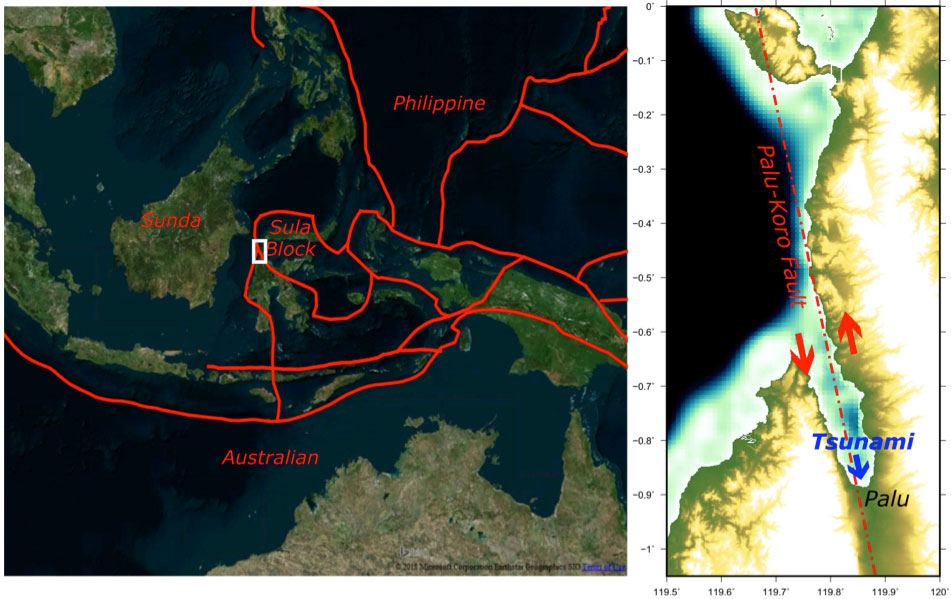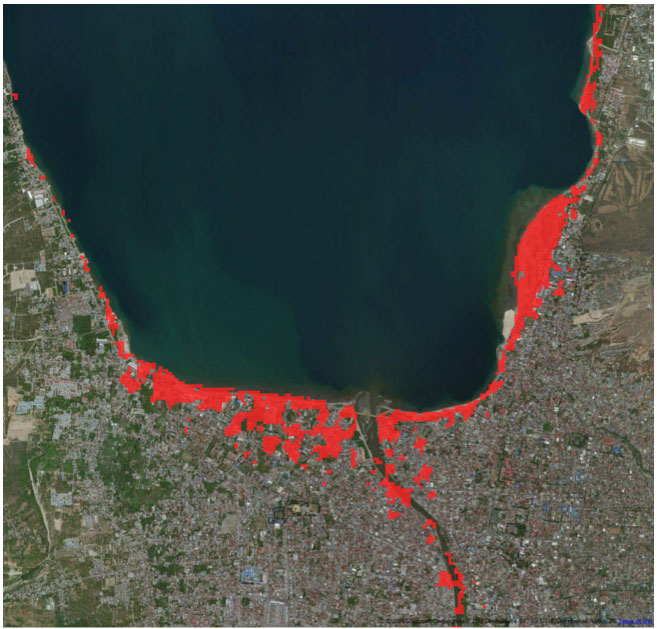
Surrounded by many large and active subduction zones and some of the largest crustal faults, Indonesia is one of the most seismically active countries in the world. The September 28 M7.5 earthquake and tsunami near Palu in central Sulawesi killed more than 1,400 people. The magnitude of this temblor might be surprising to many, but not to those in the scientific community.
The September 2018 earthquake likely occurred due to slip on the fast slipping, predominantly strike-slip, NNW trending, Palu-Koro fault at the western boundary of the North Sula block (Figure 1), which forms part of the complex triple junction at the intersection of the Australian, Philippine, and Sunda plates (Figure 1). The fault accommodates up to 40 mm/year of left-lateral motion (with some normal component) due to block rotation [Bellier et al., 2001; Socquet et al., 2006]. The strain accumulates over many decades or centuries and is released suddenly over a few seconds as the fault slips during the earthquake, causing the ground to shake.

According to the USGS report, the M7.5 earthquake nucleated at a depth of ~10 km, about 80 km north of Palu. Aftershock data suggests that the rupture propagated south toward the densely populated city. Preliminary estimates of surficial slip in Palu, derived by tracking pixels in optical images acquired by satellites before and after the earthquake, are as high as 6 meters. Given the large magnitude this is not surprising. The alluvial deposits on which most of the city is built could have damped some of the high frequency ground motion closer to the fault, while at the same time amplifying longer periods that can cause damage to taller buildings and structures. Unfortunately, the proximity of the city to the fault and to the ocean meant that its residents not only had to deal with shaking but also the subsequent tsunami. Waves, reportedly as high as 6 meters (20 feet) arrived relatively quickly and with little warning. Figure 2 shows the extent of areas around Palu with elevation less than 6 meters and which may have been prone to inundation following tsunami runup.

Most tsunamis are caused by seafloor deformation following slip on large reverse faults such as those near subduction zones or offshore normal faults. In addition, however, large strike-slip earthquakes near the shore often produce tsunamis. The waves can be generated by seafloor deformation following slip on the fault itself or submarine landslides triggered by intense shaking. The focal mechanism of the Palu earthquake (i.e., ~70-degree dip and ~-20-degree rake, respectively) along with its magnitude suggest relative vertical deformation as high as 1 to 2 meters near the source. Complex bathymetry (underwater topography) with steep gradients can also generate waves due to the horizontal motion of the seafloor. These waves, as they approach the shore, amplify due to the gradually shallowing bathymetry and focusing of energy, causing runup and widespread damage in low-lying coastal areas. This effect can be exacerbated within coastal inlets, such as the one Palu sits at the end of.
The devastation and major loss of life in Indonesia serve as a stark reminder that earthquakes can produce locally devastating tsunamis as well as landslides with relatively little warning.
